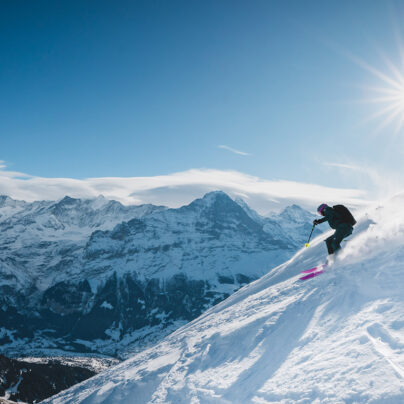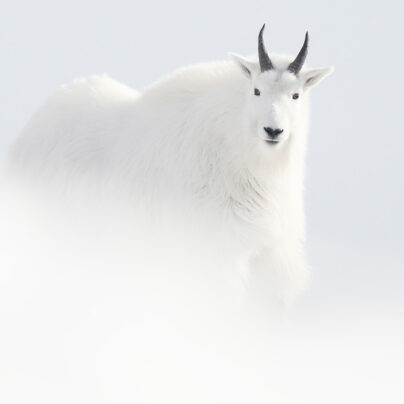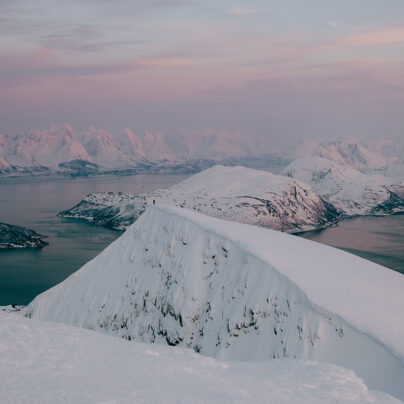A Baffin Vacation
Whitewater and Granite Towers on Baffin Island
Words by Sarah McNair-Landry // Photography by Erik Boomer & Sarah McNair-Landry
On our map, the river has no name. ‘Look at that!’ Boomer yells. But my kayak, a crushing weight carefully balanced on one shoulder, blocks my view. It’s unwieldy with food and camping equipment. I don’t want to put it down until I catch up – getting it back onto my shoulder is no easy task.
When I catch up with Boomer, I drop my kayak on the tundra beside his boat, stretch my neck left to right to work out some of the tension, and only then notice the strip of whitewater cascading down the mountainside. Plumes of mist spray into the air. ‘Look at that waterfall! Maybe we can camp here and go scout the river?’ Boomer’s words come out with rapid-fire excitement. Having only seen the river on low-res satellite images, we still have many unanswered questions. Will the flows be good? Will the rapids be runnable? Will the rivers be worth all this effort – worth investing an entire summer and a hell of a long approach? I can’t help a slight feeling of apprehension. Much as I love this, Boomer has been known to sandbag me. Rapids he considers runnable are sometimes right at the edge of my abilities. Is this an expedition, or is it a holiday? Maybe it depends on attitude. We’re here to have fun.
We had set out in late June from the small community of Clyde River on the east coast of Baffin Island. Kayaks and sleds loaded with 45 days’ worth of food, plus gear for kayaking, camping, and climbing, we skied 100km across the quickly melting sea ice into Inuksuit Fiord. There we set up a base camp and spent 10 days climbing some of the surrounding rock formations before caching our climbing gear and heading further into the fjord. After paddling down the fjord, kayaks heavy with a portion of our supplies for the next stage, we began the hike inland to search for rivers.


Wearing our drysuits, Boomer and I hike along the rim of the canyon that funnels the river below, making slow progress over the rocky terrain. We peer over the steep banks to get a better look at the rapids. Some of the waterfalls smash straight into rocks – too dangerous to paddle. But the upper two drops catch Boomer’s attention. Sluicing through a gorge, the first drop pours over a lip into a big pool before it drops again and explodes into a chaotic cascade. Is it runnable? There’s tremendous power in the river as it cuts through the canyon, and I scan the line from above, trying to predict where a boat would end up after crashing over that vertical wall of water.
It’s too late in the day to paddle. Dark clouds are looming on the horizon. Eager to take shelter from the approaching storm, we set up camp just above the bank. Rain batters our tent all night. Gusts of wind gain speed as they hurtle down the valley before colliding with the nylon of our shelter. Early in the morning, when Boomer unzips the vestibule and heads outside to pee, I exclaim, ‘It sounds like the river is just outside our tent.’ A moment’s pause. ‘Woah,’ he calls back. ‘The river is just outside our tent.’
I lift the door flap and peer outside. The banks are flooded. That small ripple in the river’s surface dead ahead has become a fearsome torrent. I look for features I can identify, and my attention latches onto a particular boulder I noticed the evening before. Now only the top of the rock is visible – the river has risen four vertical feet overnight. It’s far too big and burly to paddle now.
We move camp to higher land, Boomer places river markers on the banks, and we patiently wait for the river drop.
***
Boomer stands at the lip of the waterfall. His gaze follows the current as it narrows into a spout and freefalls 40–50ft into a pool below, calming only momentarily before gaining speed and dropping another 60ft into a violent slide. The energy in this place is palpable, almost frightening – especially knowing how remote we are from help should anything go wrong. But Boomer doesn’t hold back. He gives me a thumb-up before dropping down the riverbank with his kayak over one shoulder.
Throwline bag ready in one hand, I bring my camera up to my eye with the other and watch him paddle out into the flow. Now the current has him in his grip. Irresistible forces take hold. As his yellow boat freefalls into the pool below and vanishes into the churn, I hold my breath. He’s gone for long moments, hidden by foam and spray – and then I spot his boat surging up through the surface at the bottom and I can breathe again. He throws up a hand and lets out a riotous hoot of celebration, in those few seconds before he must focus on the paddle over the next waterfall. Then he’s gone once more. More tense moments until I see him reappear near the bottom of the run.
Just like that, it’s over. I portage my boat around the set of falls and down to the bottom of the canyon, where I hug Boomer, his drysuit streaming with water. But there’s a big grin on his face. His elation is infectious. ‘Yeah, way to style those waterfalls!’ I congratulate him. Tomorrow, I know, it’ll be my turn to paddle some challenging rapids.



‘There’s tremendous power in the river as it cuts through the canyon below us, and I scan the line from above, trying to predict where a boat would end up after crashing over that vertical wall of water.’
That night the rain pounds on the side of our tent once again, and the next morning we find the river back in flood for a second time. Today we decide to go for it. Swift rolls and no swims. Boomer’s advice runs through my head as I reach out and plant my paddle into the current, propelling my kayak into the fast-moving water. My boat instantly picks up speed as the river grabs me and hurls me along with its flow.
I come around the corner at speed and slam right into the shore. Solid ground catches the side of my boat and I tip over in the exact spot Boomer had pointed out as ‘not a great spot to be upside down’. The turbulent water is disorienting and I force my paddle towards the surface, tucking my body close to the boat to protect my head from the rocks, and set up to roll myself back upright.
I recover and paddle into the next rapids just downstream. The current is moving fast, and I take a deep breath, silently repeating my line like a mantra: river left, then move right to avoid rocks, then middle left, then hard river right. The rapid mellows and I draw next to Boomer’s boat in the pool below. High five. ‘You ready for more?’ he asks as he paddles back into the current. ‘I can’t wait,’ I reply, unable to hold back a smile as I follow.
Later, having quenched our thirst for whitewater, Boomer and I make our way down the river before leaving it to hike over a pass and paddle along the ocean. From here we retrace our route to where we stashed our climbing gear. It’s time to head back into the mountains.



‘We’re not going the right way, but at least we are going,’ Boomer shouts from above.
With 10 days left, we’ve switched gears from kayaking to climbing. Our first objective is a tower that a friend had climbed years before. They described it as a moderate route up a picturesque tower. But our weaving line up the cliff is rewarded with dead ends, forcing us to downclimb and find a different route. And it’s loose. The occasional rock plummets from above, so we choose our belay ledges carefully, looking for any kind of shelter. Neither of us get much of a chance to appreciate the view, but occasionally I snatch glances back down the wall: scree, snowfields, and the blue-green waters of the fjord.
‘You’ll want to wear your rain jacket for this section – it’s awful,’ Boomer yells down at me as I get ready to follow him up. The next pitches are wet and mossy cracks, all much harder than anything our friends had described (we later learn that our route is nowhere near theirs). I jam a hand and foot into the crack, desperately trying to get any grip on the wet rock. It’s a brutal fight. By the time I reach Boomer at the belay, sticky mud covers me to my elbows and knees, and I’m starting to wonder if we’ll ever reach the top of this tower.
I look up. The top seems so close, yet out of reach. The perpetual daylight is disorienting, and it’s easy to lose track of time. After climbing through the night, the morning sun wraps around the tower and hits our ledge, giving me an extra boost of energy – or maybe it’s the caffeine tablet I just took. Boomer is above, questing up a hard pitch, and I hear a grunt of frustration, then: ‘There are big loose blocks. And I can’t figure out another way.’
I lower him back down to my ledge. Standing close together, connected to the anchor and to each other, we gaze down at a pod of beluga whales swimming in the ocean below. It’s a moment of calm, taking us out of the whirlpool of concentration and emotions that we’ve been orbiting ever since we set foot on this wall. Now we ponder our way ahead – and what we’re doing here. Fatigue burns in my calves.
We gave it our best. Time to head back to camp.



After a day of rest, some additional scouting, and one more good day in the forecast, we decide to head back to give the tower another attempt. But I lie awake most of the night, images of the climb churning in my mind: the wet mossy pitches, the loose rock, the final hard section. Eventually, it’s 1.00am. I hear Boomer rustling on his side of the tent. Is he sharing my anxieties? ‘Boomer, are you sleeping?’ ‘No,’ he says. After a pause, I say: ‘I have a weird feeling about the tower. Is it worth it just to be able to say we summited?’
Neither of us wants to back away from our initial plan, yet neither of us feels excited about heading back up the tower. Aren’t we here to have fun? We talk about what we’re looking for in a climb: challenge, yes, but there is a fine line. ‘Let’s just go climb good rock,’ Boomer says eventually. I agree.
We load our kayaks with our climbing gear. Instead of heading west towards the tower, we head east to the White Wall – to a climb established in 2012 by the Spanish team including the Pou brothers. Here we find ourselves at the base of an intimidating climb. A glacier wraps around the base of a granite wall that looks steep – very steep – but the rock is dry and clean, and we make our way up a beautiful crack system that becomes a massive corner crack. It isn’t easy, but we were never looking for easy.
The midnight sun allows us to climb through the night. As we make our way higher and higher, we give ourselves permission to stop every now and again to gaze out across the otherworldly views of Baffin’s wild landscape. Expedition or vacation? It may be a fine line, but I can’t imagine a more spectacular place for seeking just the right kind of fun.
First published under the title ‘Fine Lines’ in Sidetracked Volume 24
Find out more about making the film via our behind the scenes interview: 45 Days, No Backups
A Film by Sarah McNair-Landry and Erik Boomer // @sarahmcnairlandry // @erikboomer
Presented by Whitewater // @usnwc // @riverrootsproductions
Produced by Erik Boomer, Sarah McNair-Landry, and Rush Sturges // @rushsturges






